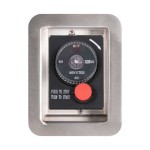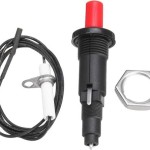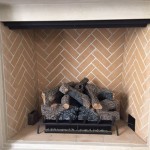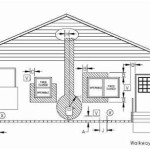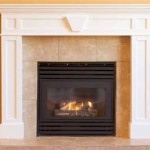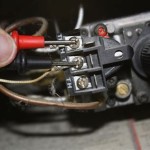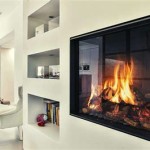Fireplace Door Hardware: A Comprehensive Guide
Fireplace doors serve a crucial function in home heating and aesthetics. They enhance safety by containing sparks and embers, improve energy efficiency by preventing drafts when the fireplace is not in use, and add a decorative element to the living space. However, the efficacy and longevity of fireplace doors are significantly influenced by the quality and functionality of their hardware. This article provides an in-depth exploration of the various types of fireplace door hardware, their functionalities, materials, maintenance, and factors to consider when selecting the appropriate hardware for a specific fireplace.
Types of Fireplace Door Hardware
Fireplace door hardware encompasses a range of components that facilitate the operation and security of the doors. These parts work in conjunction to allow smooth opening and closing, secure latching, and aesthetically pleasing integration with the overall fireplace design. The specific hardware required will vary depending on the type of door, its size, and the desired functionality.
Hinges: Arguably the most crucial element, hinges allow the doors to swing open and closed. They must be robust enough to support the weight of the doors and withstand repeated use. Several types of hinges are available, including:
- Butt Hinges: These are the most common type, consisting of two rectangular leaves joined by a pin. They are mortised into both the door and the frame, providing a flush and clean appearance.
- Strap Hinges: Characterized by their long, decorative straps, these hinges are often used on larger or rustic-style doors. They provide enhanced support and visual appeal.
- Pivot Hinges: These hinges allow the door to pivot around a central point, offering a unique opening mechanism. They are suitable for doors that need to swing a full 180 degrees.
- Offset Hinges: These are used when doors need to clear obstructions or swing wider than standard hinges allow.
The choice of hinge depends on the weight of the door, the desired aesthetic, and any specific functional requirements. Heavier doors will require stronger hinges, and decorative hinges can enhance the overall style of the fireplace.
Latches: Latches are responsible for securing the doors when closed. They prevent the doors from swinging open unintentionally, ensuring safety and maintaining energy efficiency. Common latch types include:
- Cam Latches: These latches feature a rotating cam that engages with a strike plate on the frame. They are simple, reliable, and commonly used on smaller doors.
- Magnetic Latches: Utilizing magnets to hold the doors closed, these latches offer a clean and minimalist appearance. They are suitable for lighter doors and provide easy opening and closing.
- Bolt Latches: Offering a more secure closure, bolt latches typically consist of a sliding bolt that engages with a receiver on the frame. They are often used on larger or heavier doors.
- Spring-Loaded Latches: These latches automatically engage when the door is closed, providing convenience and a secure seal.
The selection of a latch should consider the desired level of security, the weight of the doors, and the ease of operation. A secure latch is paramount for preventing sparks and embers from escaping the fireplace.
Handles: Handles provide a means to easily open and close the fireplace doors. They are available in a wide variety of styles and materials to complement the overall design of the fireplace. Considerations for handle selection include:
- Material: Handles can be made from various materials, including iron, brass, stainless steel, and wood. The material should be heat-resistant and durable.
- Style: Handles come in various styles, ranging from simple knobs to ornate levers. The style should complement the overall aesthetic of the fireplace.
- Size: The size of the handle should be appropriate for the size of the door and the user's comfort.
- Heat Resistance: Critical for safety, the handle must be made of material and designed to prevent excessive heat transfer, protecting the user's hand.
Choosing handles that are both aesthetically pleasing and functionally ergonomic is important. Consideration should be given to the material's heat conductivity to avoid burns during fireplace use.
Strike Plates: Strike plates are metal plates that are mounted on the fireplace frame and receive the latch. They provide a secure point of engagement for the latch, ensuring that the doors close properly and securely. The material and construction of the strike plate should be durable and resistant to wear and tear.
Other Hardware: Depending on the design, other hardware components may include dampers, screens, and decorative elements. Dampers control airflow within the fireplace and are often integrated into the door assembly. Screens prevent sparks and embers from escaping. Decorative elements can enhance the aesthetic appeal of the fireplace doors.
Materials Used in Fireplace Door Hardware
The materials used in the construction of fireplace door hardware significantly impact its durability, performance, and aesthetic appeal. The high temperatures generated by a fireplace necessitate the use of heat-resistant and robust materials. The most common materials include:
Iron: Iron is a popular choice for fireplace door hardware due to its strength, durability, and heat resistance. It is often used for hinges, latches, and handles, particularly in traditional or rustic-style fireplaces. Cast iron is a common form employed for heavier-duty components. Iron is susceptible to rust, so it is often coated with a protective finish to prevent corrosion.
Steel: Steel, particularly stainless steel, offers excellent strength, corrosion resistance, and heat resistance. It is commonly used for hinges, latches, handles, and frames. Stainless steel provides a sleek and modern appearance and is suitable for contemporary fireplaces. Carbon steel provides structural integrity for underlying supports.
Brass: Brass is a durable and corrosion-resistant material that is often used for decorative hardware, such as handles and accents. It adds a touch of elegance and sophistication to the fireplace. Brass requires polishing to maintain its shine and prevent tarnishing.
Aluminum: Aluminum is a lightweight and corrosion-resistant material that is sometimes used for fireplace door frames and handles. It is not as strong or heat-resistant as iron or steel but is suitable for less demanding applications. Anodized aluminum is often used to enhance its durability and appearance.
Ceramic: High temperature ceramic can be used for handle grips or decorative accents. It is heat resistant to the touch and provides insulation from the metal components of the door. Ceramic adds a unique aesthetic to the fireplace door hardware.
The choice of material depends on the desired aesthetic, the level of heat exposure, and the budget. Steel and iron are generally more durable and heat-resistant than aluminum and brass, while brass offers a more decorative and elegant appearance.
Factors to Consider When Selecting Fireplace Door Hardware
Selecting the appropriate fireplace door hardware requires careful consideration of several factors, including the type of fireplace, the size and weight of the doors, the desired aesthetic, and the budget. By considering these factors, homeowners can ensure that they choose hardware that is both functional and visually appealing.
Fireplace Type: The type of fireplace will influence the choice of hardware. For example, a traditional masonry fireplace may require different hardware than a modern gas fireplace. The existing style and construction of the fireplace should be considered when selecting hardware.
Door Size and Weight: The size and weight of the doors are critical factors in determining the appropriate hardware. Heavier doors will require stronger hinges and latches to ensure proper operation and security. The hardware should be rated to handle the weight of the doors.
Aesthetic Considerations: The hardware should complement the overall design of the fireplace and the surrounding room. Consider the style, finish, and material of the hardware to ensure that it integrates seamlessly with the existing décor. Hardware is available in a wide range of styles, from traditional to contemporary.
Functionality: The hardware should be easy to operate and provide a secure closure. Consider the type of latch, the ease of opening and closing the doors, and any additional features, such as dampers or screens. The hardware should enhance the functionality of the fireplace.
Durability and Heat Resistance: The hardware should be made from durable and heat-resistant materials to withstand repeated use and exposure to high temperatures. Choose materials that are resistant to corrosion and wear and tear. Regular maintenance can extend the lifespan of the hardware.
Budget: Fireplace door hardware is available at a wide range of price points. Set a budget before shopping and choose hardware that meets the functional and aesthetic requirements while staying within the budget. Consider the long-term value and durability of the hardware when making a purchase.

Mounting Hardware Kit For Masonry Fireplace Doors With Lintel Iron
.PNG?strip=all)
Mounting Hardware Kit For Masonry Fireplace Doors With Lintel Iron

Mounting Hardware Kit For Masonry Fireplace Doors With Lintel Iron

Standard Lintel Clamp Mounting Kit With End Brackets

Pleasant Hearth Fireplace Doors Installation

Masonry Fireplace Door Stoll Lintel Mounting Hardware Kit

Fireplace Doors What Part Am I Missing Doityourself Com Community Forums

Mounting Hardware Kit For Masonry Fireplace Doors With Lintel Iron

Stoll Sliding Fireplace Door Stylish Fireplaces

The Ez Door Steel For Lennox Fireplaces Fireplace
Related Posts

